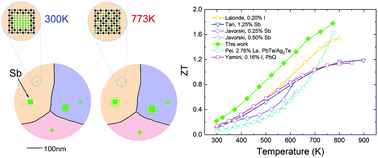当前位置:
X-MOL 学术
›
Energy Environ. Sci.
›
论文详情
Our official English website, www.x-mol.net, welcomes your feedback! (Note: you will need to create a separate account there.)
Large enhancement of thermoelectric properties in n-type PbTe via dual-site point defects
Energy & Environmental Science ( IF 32.5 ) Pub Date : 2017-08-16 00:00:00 , DOI: 10.1039/c7ee01871a Liangwei Fu 1, 2, 3, 4, 5 , Meijie Yin 1, 2, 3, 4, 5 , Di Wu 1, 2, 3, 4 , Wei Li 1, 2, 3, 4 , Dan Feng 1, 2, 3, 4 , Li Huang 1, 2, 3, 4 , Jiaqing He 1, 2, 3, 4
Energy & Environmental Science ( IF 32.5 ) Pub Date : 2017-08-16 00:00:00 , DOI: 10.1039/c7ee01871a Liangwei Fu 1, 2, 3, 4, 5 , Meijie Yin 1, 2, 3, 4, 5 , Di Wu 1, 2, 3, 4 , Wei Li 1, 2, 3, 4 , Dan Feng 1, 2, 3, 4 , Li Huang 1, 2, 3, 4 , Jiaqing He 1, 2, 3, 4
Affiliation

|
The relatively inferior performance of n-type legs impedes the application of PbTe materials in intermediate temperature thermoelectric devices. In order to elevate the thermoelectric properties of n-type PbTe, we added some Sb phases into 0.1% PbI2-doped PbTe by a conventional melting method. Transmission electron microscopy (TEM) analysis together with density function theory (DFT) calculations showed that endotaxial Sb nanoprecipitates were produced in the PbTe samples at room temperature, and that part of these nanoprecipitates gradually dissolved into the PbTe matrix to form SbPb–SbTe dual-site substitutional point defects as temperature increased. A maximum ZT of about 1.8 was achieved at 773 K for the n-type PbTe0.998I0.002–3%Sb composite due to a simultaneous improvement in power factor and reduction in lattice thermal conductivity. In the PbTe0.998I0.002–x%Sb (x = 1–4) composite samples, the Seebeck coefficient was much higher than that of the reported single-phase PbTe samples with similar carrier concentration, which mainly originated from distortion of the density-of-states caused by Sb dual-site doping. Simulations based on the Callaway model suggested that the SbPb–SbTe dual-site substitutional point defects also played an important role in decreasing the lattice thermal conductivity at elevated temperature. We propose that the synergistic role of Sb in both electrical and thermal transport should be highly applicable in other bulk thermoelectric materials.
中文翻译:

通过双位点缺陷大大增强了n型PbTe中的热电性能
n型支腿的性能相对较差,阻碍了PbTe材料在中温热电设备中的应用。为了提高n型PbTe的热电性能,我们通过常规熔化方法将一些Sb相添加到0.1%PbI 2掺杂的PbTe中。透射电子显微镜(TEM)分析和密度泛函理论(DFT)计算表明,室温下PbTe样品中产生了内轴Sb纳米沉淀,并且这些纳米沉淀的一部分逐渐溶解到PbTe基质中,形成Sb Pb –Sb Te随着温度升高双位点取代点缺陷。对于n型PbTe,在773 K时达到的最大ZT约为1.80.998 I 0.002 –3%Sb复合材料,因为同时提高了功率因数并降低了晶格热导率。在PbTe 0.998 I 0.002 – x%Sb( x = 1-4)复合样品中,塞贝克系数大大高于所报道的载流子浓度相似的单相PbTe样品的塞贝克系数,这主要是由于密度畸变引起的。锑双位点掺杂引起的态变化。基于Callaway模型的模拟表明,Sb Pb –Sb Te双位取代点缺陷在降低高温下的晶格热导率方面也起着重要作用。我们建议Sb在电和热传输中的协同作用应高度适用于其他散装热电材料。
更新日期:2017-09-13
中文翻译:

通过双位点缺陷大大增强了n型PbTe中的热电性能
n型支腿的性能相对较差,阻碍了PbTe材料在中温热电设备中的应用。为了提高n型PbTe的热电性能,我们通过常规熔化方法将一些Sb相添加到0.1%PbI 2掺杂的PbTe中。透射电子显微镜(TEM)分析和密度泛函理论(DFT)计算表明,室温下PbTe样品中产生了内轴Sb纳米沉淀,并且这些纳米沉淀的一部分逐渐溶解到PbTe基质中,形成Sb Pb –Sb Te随着温度升高双位点取代点缺陷。对于n型PbTe,在773 K时达到的最大ZT约为1.80.998 I 0.002 –3%Sb复合材料,因为同时提高了功率因数并降低了晶格热导率。在PbTe 0.998 I 0.002 – x%Sb( x = 1-4)复合样品中,塞贝克系数大大高于所报道的载流子浓度相似的单相PbTe样品的塞贝克系数,这主要是由于密度畸变引起的。锑双位点掺杂引起的态变化。基于Callaway模型的模拟表明,Sb Pb –Sb Te双位取代点缺陷在降低高温下的晶格热导率方面也起着重要作用。我们建议Sb在电和热传输中的协同作用应高度适用于其他散装热电材料。


























 京公网安备 11010802027423号
京公网安备 11010802027423号